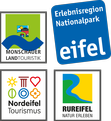Schmugglerweg [60]
Nideggen-Schmidt
The road takes its name from the post-war period, when coffee smuggling from Belgium was one of the most important sources of income for the people of Schmidt. Schmidt was over 90% destroyed at the end of the Second World War, including the parish church of St. Hubertus. With the profits from smuggling coffee across the nearby border, the people of Schmidt got their families through and rebuilt their destroyed houses. Of course, this did not go unnoticed by the parish priest at the time, Josef Beyer. The reconstruction of the church initially progressed somewhat less quickly. He said in a sermon: "I know that you are getting a headache from all the money. For me, it's the other way around, because I don't know where to get the money to rebuild the church." From then on, the smugglers sacrificed part of their profits from the coffee business to rebuild the church. This is why it is popularly known as St. Mokka.





